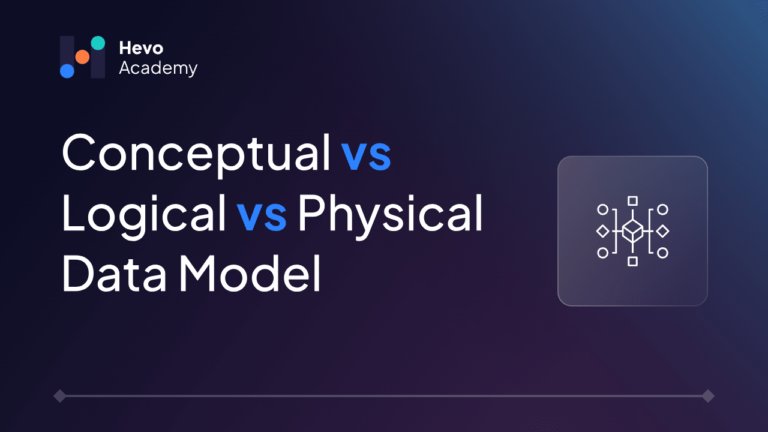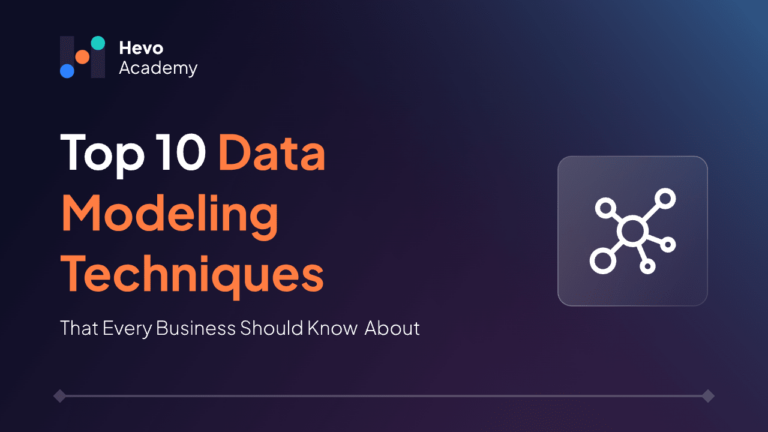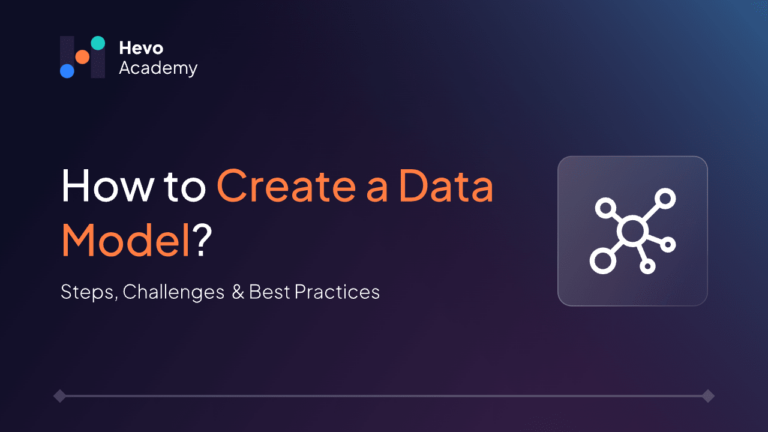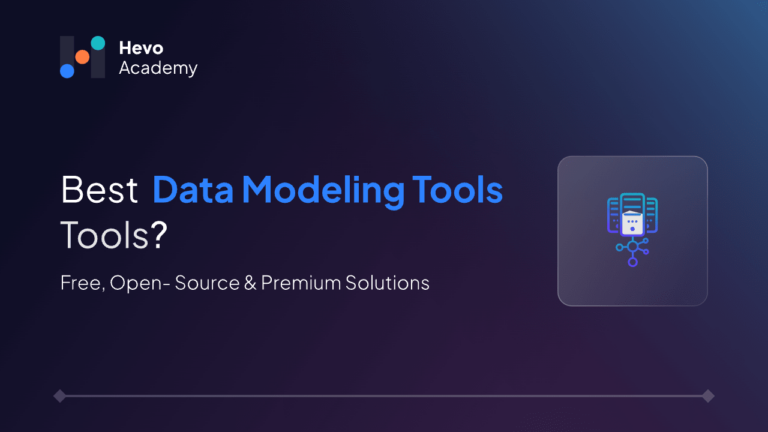Data modeling does not only involve structuring of the data, but it is a framework that bases significant decisions in companies. In my practice, I have learned that data modeling is not only knowing definitions but visualizing how these models exist in practice. Therefore, In this blog, we’ll explore three fundamental types of data models. These layers include the conceptual layer, the logical layer, and the physical layer, and give you examples of applying them to close the gap between the textbook and the real world.
Table of Contents
If you understand the roles, distinctions, and uses of each, then it puts you in a good position to master how to design efficient data systems. No matter if you are a newcomer to the world of data science or you are an expert this guide will answer questions and set clear paths.
It serves as a guide used by database analysts and software developers in the design and implementation of a system and the underlying database. This blog will provide a detailed comparison of Conceptual vs Logical vs Physical Data Models, highlighting their unique roles, distinctions, and real-world applications.
What is Data Modeling?
Data modeling is the process of showing the structures, attributes, and relationships of data through a system in order to have a clear understanding of how the system is handling data. It helps in filling the gap between the business needs and the functional databases and attains the goal of effectiveness.
The aim of data modeling is to identify and show the kind of data that are utilized as well as the one to be stored, also how these data types are connected, various manners of categorizing and arranging the data, and formats and characteristics of the data.
Data models are built based on business requirements. Feedback from stakeholders helps define rules and specifications, enabling the creation of new systems or redesigning existing ones to improve problem-solving and efficiency.
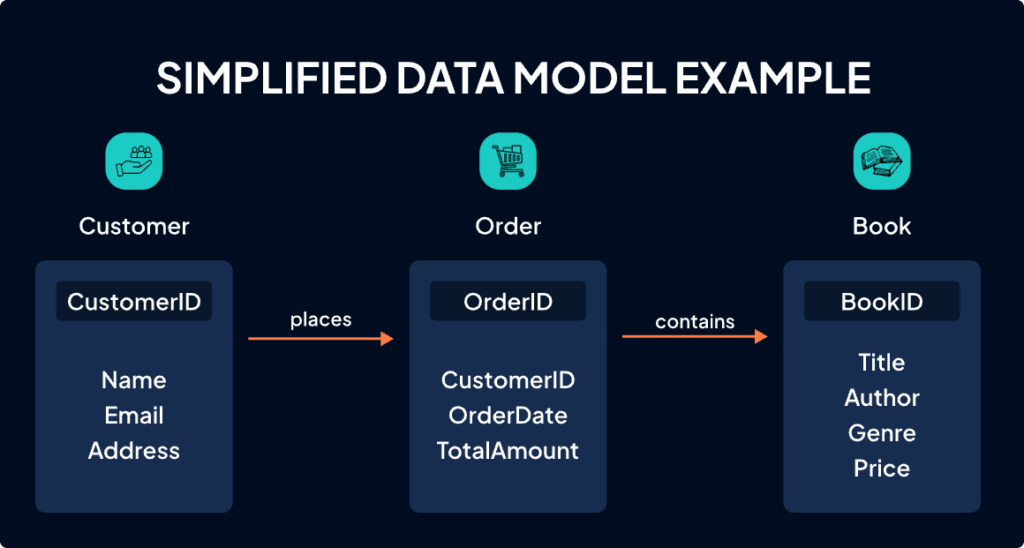
Advantages of Data Modeling
- Clarity in requirements: Reduces the gap between business and technology personnel and helps get everyone on the same page.
- Improved database design: It has a way of doing away with duplication and improving productivity.
- Error reduction: Helps recognize contradictions at the beginning of the development.
- Future-proofing: Helps systems to grow as well as prepares them for integration.
- Better performance: Tune queries and system procedures.
Disadvantages of Data Modeling
- Time-consuming: Needs considerable time in the analysis and design stage.
- Complexity: Sometimes, things can become overly complicated, especially in large systems.
- Rigidity: May involve a significant amount of effort in order to make it change to support new business requirements.
- High dependency: Dependent on the proper entries made at the initial stage.
Why is Data Modeling Important?
Data modeling is important because it establishes a common frame of reference as to how data moves within an organization. It helps close the business and technical strategies’ gap, guaranteeing alignment in procedures. It is invaluable when implementing a new system and equally beneficial when refining an old one; data modeling greatly reduces mistakes and greatly enhances your data.
Data modeling helps developers, data architects, business analysts, or any stakeholder to easily visualize and comprehend the relationships that exist between the data stored in a database or data warehouse.
In addition, it can:
- Minimizing chances of mistakes happening in software and database development.
- Improve control over documentation and structure of the systems throughout the enterprise.
- Optimize stress on the application, as well as the database.
- It simplifies the whole process of mapping the data across the organization.
Comparison of conceptual vs logical vs physical data models
Here is a more concise tabular comparison of conceptual vs logical vs physical data models:
| Feature | Conceptual | Logical | Physical |
| Entities/Tables | High-level concepts | Defined, with attributes | Actual database tables |
| Attributes | Identified | Defined, with types | Mapped to columns |
| Keys | Primary/foreign keys | Primary/foreign keys | Key constraints |
| Relationships | Identified | Defined, with cardinality | Foreign key relationships |
| Data Types | High-level types | Specific data types | Database data types |
| Constraints | Identified | Defined rules/validations | Implemented constraints |
| Indexes | Not considered | Not considered | Defined for performance |
| Storage | Not considered | Not considered | Physical implementation |
The key differences are:
- Conceptual Model: Centered on abstract business problems and objectives and does not encompass how these can be deployed in practice.
- Logical Model: Takes the general blueprint forward to define the detailed aspects of data as well as both the relationships between the data and the constraints.
- Physical Model: Concerned with mapping the actual concepts into the physical database – how it will be stored, how indexing will be done, and many other similar technicalities.
What is a Conceptual Data Model?
CDM stands for conceptual data model, and it is the highest level of data modeling. It focuses on the key actors in the business and how they connect without considering the procedure for the connection.
The conceptual model defines the overall architecture of the business under consideration – what the most critical concepts are, what properties they possess, and how they are connected. It is the big picture that will see the establishment of the entire empiric system.
Conceptual Data Model Example
This may theoretically be illustrated by a library management system. In this case, the key entities and their relationships might look something like this:
Conceptual Data Model:
- Entity: Book
- Attributes: Title, Author, ISBN, Genre, Publication Date
- Entity: Member
- Attributes: MemberID, Name, Email, Address
- Entity: Checkout
- Attributes: CheckoutID, BookID, MemberID, CheckoutDate, DueDate, ReturnDate
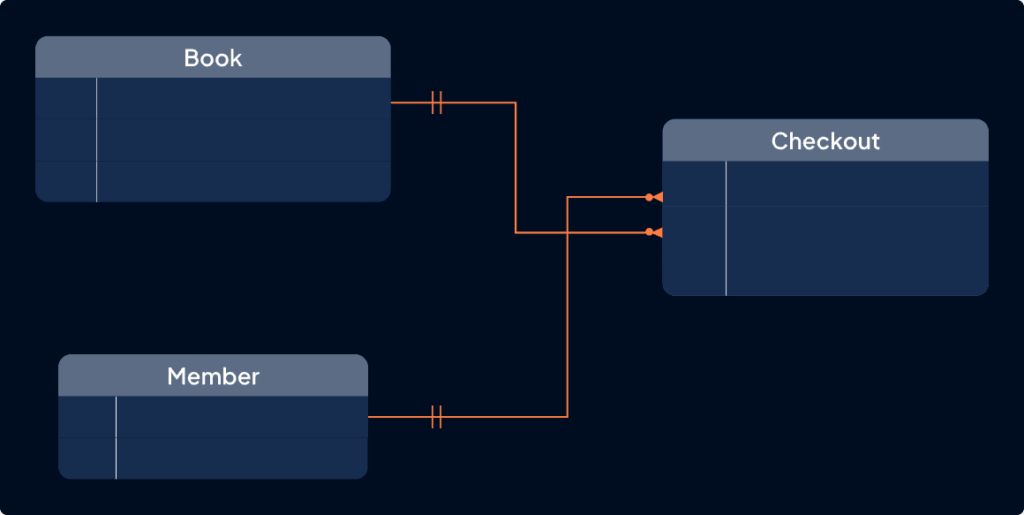
Benefits of Conceptual Data Model
Here, we look at some of the benefits of using the Conceptual Data Model;
- Simplified communication: Focuses on business needs.
- Foundation for other models: It gives a point from which logical and physical models can be developed.
- Stakeholder involvement: Can be communicated without making gestures to technicality and complexity by other stakeholders.
- Better business understanding: It only guarantees everyone is on the same page as far as the business specifications and data exigencies are concerned.
- Flexibility: It facilitates easy evolution when the business is advancing or when there are changes.
What is a Logical Data Model?
A logical data model is a detailed representation of the conceptual model worked on, and the way entities and relationships between them are structured in data form. It sets the attributes of data, including data type and size, and does not cover system specifications.
This means that if one delivers a logical data model (LDM), it has more detail than the conceptual model. It specifies attributes of the entities and interactions between them so that it is normalized and no redundant data exists.
It is regularly applied to work, for instance, in implementing a data warehouse or reporting solution but is not needed for agile or DevOps approaches. This type of chart gives a representation of a set of data and does not overly concern itself with how it will be implemented.
Logical Data Model Example
At the level of a logical data model, we would further elaborate this by stating the data types, constraints, and other details regarding the entities and their attributes. For example:
Logical Data Model for Library:
- Book
- BookID (Primary Key, Auto-Increment)
- Title (varchar, Required)
- Author (varchar, Required)
- ISBN (varchar, Unique, Required)
- Genre (varchar)
- PublicationDate (date)
- Member
- MemberID (Primary Key, Auto-Increment)
- Name (varchar, Required)
- Email (varchar, Unique, Required)
- Address (varchar)
- Checkout
- CheckoutID (Primary Key, Auto-Increment)
- BookID (Foreign Key referencing Book table)
- MemberID (Foreign Key referencing Member table)
- CheckoutDate (date, Required)
- DueDate (date, Required)
- ReturnDate (date, Optional)
Last of all, the translation of such a logical structure into an actual database is the physical data model, which involves tables, columns, indexes, etc.
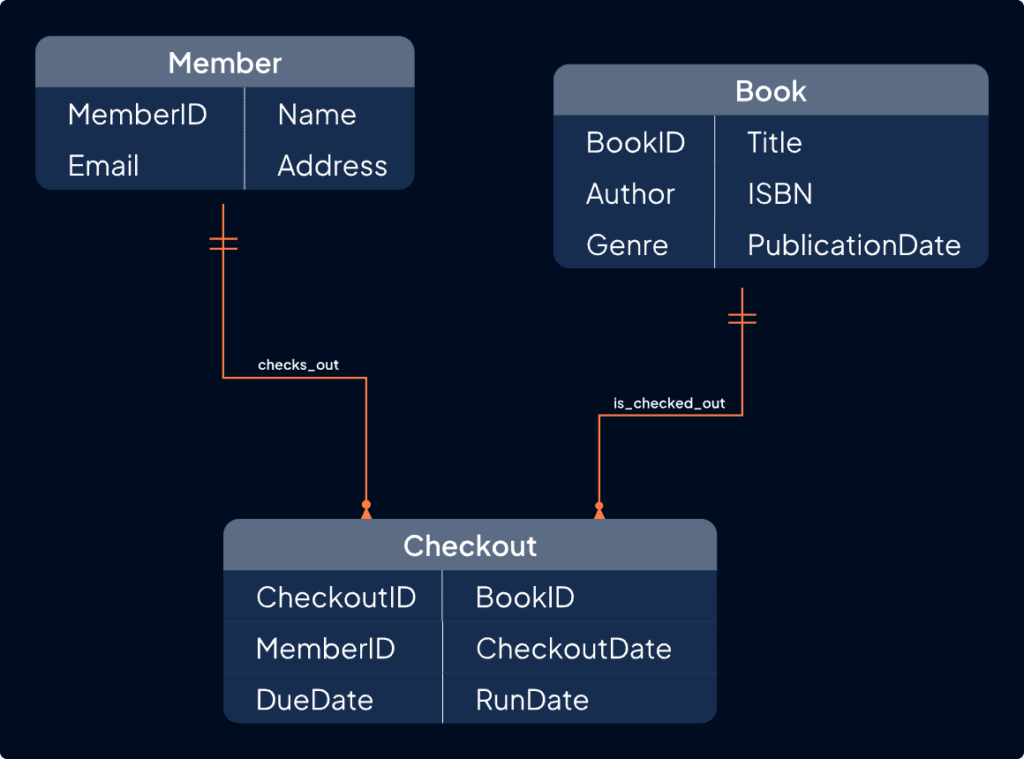
Benefits of Logical Data Model
- Data structure clarity: Makes sure that it contains all the requisite attributes.
- Normalization: Reduces repetition and guarantees uniformity of information presented to clients.
- Facilitates database design: A bridge between the requirement analysis of a business and the physical world execution of the same.
What is a Physical Data Model?
A Physical Data Model specifies how the data will be stored in a database; it depends on the implementation. It has the description of each table, the primary and foreign keys that have been employed, the relation between entities. It also contains DBMS attributes as performance tuning. This is the most refined model and is easily adaptable for use in a relational database.
Physical Data Model Example
Physical Data Model for Library example:
Book
- BookID (int, PK, AUTO_INCREMENT)
- Title (varchar, NOT NULL)
- Author (varchar, NOT NULL)
- ISBN (varchar, UNIQUE, NOT NULL)
- Genre (varchar)
- PublicationDate (date)
Member
- MemberID (int, PK, AUTO_INCREMENT)
- Name (varchar, NOT NULL)
- Email (varchar, UNIQUE, NOT NULL)
- Address (varchar)
Checkout
- CheckoutID (int, PK, AUTO_INCREMENT)
- BookID (int, FK, references Book)
- MemberID (int, FK, references Member)
- CheckoutDate (date, NOT NULL)
- DueDate (date, NOT NULL)
- ReturnDate (date)
Relationships:
- One Book can have multiple Checkouts
- One Member can have multiple Checkouts
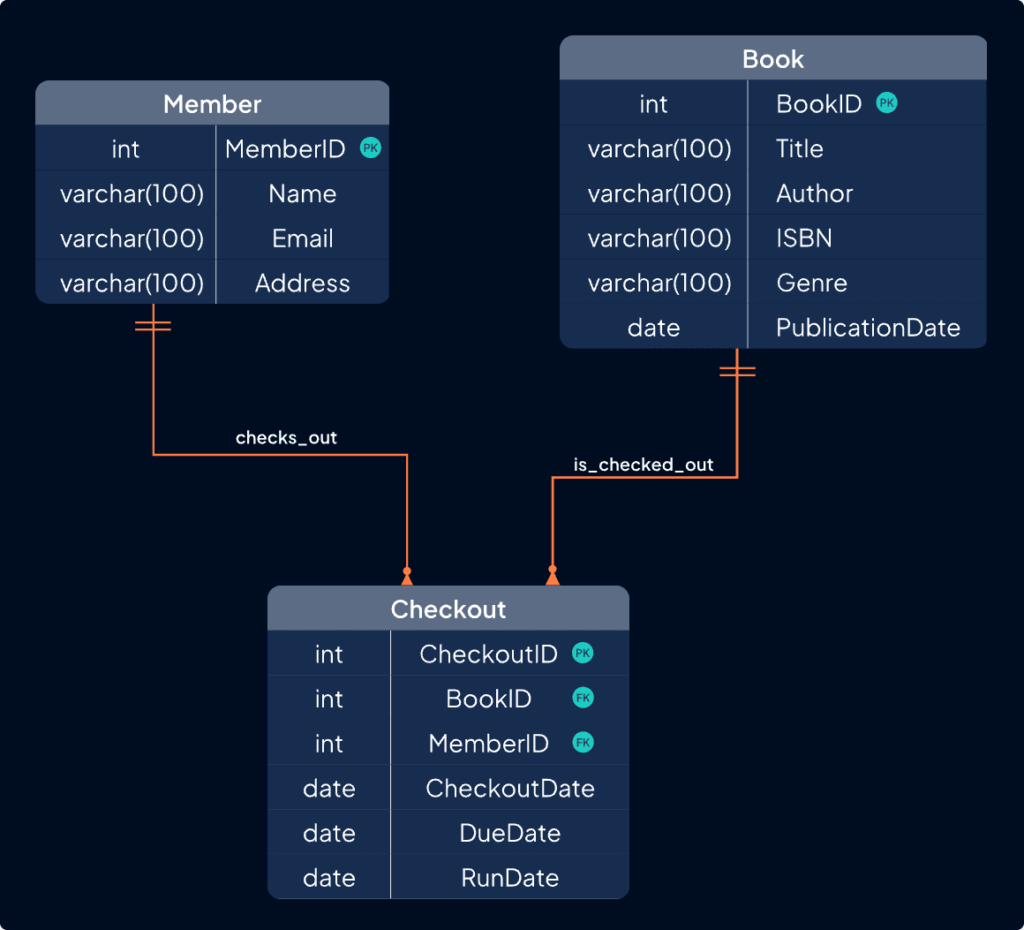
Benefits of Physical Data Model
- Implementation ready: Serves to define exact structures of respective databases.
- Performance optimization: It also comprises indexing and partitioning.
- Validation: Pays attention to the viability of the selected system for the database.
Key differences: Conceptual vs Logical vs Physical Data Model
The Conceptual Data Model is an abstract and centralized model; it covers what the business demands but does not illustrate many technicalities, showing only entities and relations. Finally, it is versatile and can be useful for those workers who do not have a technical background.
The Logical Data Model is more detailed in defining attributes and checking data to be in the normalized form without naming technical systems. Just like analysts and designers use it to organize data systematically.
The Physical Data Model is the most concrete and aggregate; it defines tables, columns, keys, and some other characteristics that are specific to the DBMS being used. It’s employed by database implementers, and the actual use involves the implementation of a database environment, which provides the least freedom.
Conclusion
In conclusion, it is important for one to know the difference between conceptual, logical, and physical data models when it comes to designing or implementing efficient data systems. First, there is the conceptual model that sets the overall business needs of the model, then there is the logical model that defines the specific detail to do with the data as well as the structure and definition of their relationship, and lastly, the physical model which implements the above said in creating the actual database.
With these three layers of data modeling skills, you will be ready to integrate business requirements with technical solutions and reduce the risk of even small mistakes to build a scalable data architecture. This extended view enables the creation of solutions based on your data and then aligns you and your company for growth and the ability to adapt to further change. Tools like Hevo can further streamline this process, enabling seamless integration, automation, and scalability for your data needs. Sign up for Hevo’s 14-day free trial and experience seamless data migration.
FAQs
1. What are the three types of data models?
These three categories of data models are conceptual, logical, and physical. All are used for different aims – to describe business needs and define the specific database design.
2. What is the difference between a physical model and a conceptual model?
A conceptual model focuses on high-level business entities and relationships, while a physical model details the database’s technical structure, including tables and columns.
3. What is a conceptual data model?
A conceptual data model provides an overview of the entities and relationships of a business free of technical implementation details and is the basis for subsequent modeling.
4. What are the 3 components of a data model?
The three major categories of a data model are entities, attributes, and relationships. Collectively, they determine the shape and path of the information inside the system.

